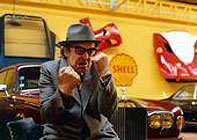|
|
|
|
Soigne ta droite
|
 |
|
It
is uncontroversial to say that, from its earliest days, the cinema of Jean-Luc Godard has been one of profound de-dramatisation. Every potentially strong,
fleshed-out fictional moment is either elided or deliberately muddled. Every
hardcore Godard fan knows only too well his inveterate, sometimes exasperating
drive to impulsively bring forth not a scene but the mere sketch of a scene, with all its ends hanging out: not a
representation per se but the wonkily diagrammatic sketch of a representation.
This is summed up in Soigne ta droite by the scene of a plane diving out of control, depicted by shaky camera view of
clouds, and a repeated sound of the cast whooping.
Once
the various modernist and political alibis for such an aesthetic were exhausted
within Godard’s career, it’s possible to sense an underlying, almost phobic
tendency on his part to want to avoid the massive effort to tell a story, any
story, to materialise any solid representational scene, or to produce any
flesh-and-blood, three-dimensional character. What’s strange and distinctive in
Godard’s work of the late ‘80s is that this palpable agony when faced with the
burden of narrative and representation is wedded to an equally intense desire
for the communication of a kind of pure, direct emotion from maker/film to
viewer – even though the actors have been reduced to quoting-head ciphers with
a repertoire of soulful, sorrowful looks.
Watching Soigne ta droite, I pondered the
extent to which a viewer ‘gets’ or shares in this quality of wistful emotional
reverie is directly proportional to his or her obsession with Godard as a
neo-Romantic artist – and a new kind of artistry that occurs beyond rather than
through character, in the realm of pure appearances: the stroke, the abstract
line, the cinematic mark or gesture like a painter’s … a caméro-stylo which surely marks the apotheosis of a certain code or
ethos of auteurism.
Hence,
perhaps it takes a certain kind of viewer to appreciate or feel any kind of depth
in the usual skein of references to the impending world catastrophe, the
“regretful smile” of Godard himself as a prominent performer here, the doorway
to death, the arising of a mood beyond despair, and so on and on …
Soigne ta droite however, along with
these usual subjects, embraces a certain fictionality
in a way that Godard’s films rarely do. One of the most remarkable scenes that he
has ever put together is the sudden (out of nowhere) scene of the Prisoner and
his Captor on the train – with its amazing image of the hand, out-of-focus and
murkily unlit in the foreground of the frame, as a landscape cascades by in
several stages in the background. There is a genuine attempt at allegory or
fable here.
This
sense of a pleasure in fiction, in conjuring weighty metaphysical imponderables
and giving them some strange gravity in the staging of a surreal story, surely
owes something to Raúl Ruiz (to whose Roof of the Whale [1982] a reference is
explicitly made). This is particularly so in the curiously affecting narration
which guides (more or less, and with looped repetitions) the film’s unfolding.
The
film lacks a clear, organic or central theme, and challenges or goads our
desire to find one. It is stuffed with the usual Godardian references to a
world of commercial barbarism, and the impending end of it all – as well as the
fragile desire to create a heavenly place on earth (“a place on earth as in
heaven” is both its alternate title and the name of the film-within-the-film),
which the flight scenes comically index.
There
is an attempt at slapstick comedy – its very title is a détournement of an early Tati short – which amounts mainly to a
lot of falling about, people bashing into one another, nothing much resembling
a real gag: just the off-centre, sliding, collision stuff familiar from his
earlier films of the decade like Prénom
Carmen (1983).
The
lyrical passages are, however, longer and freer than ever. But does this
lyricism cohere, in a deep poetic core, or does it serve to further disperse
the film-text? Take the music, for instance, especially the scenes of Les Rita
Mitsuoko recording: how does it fit in except as physical, sensual material,
and as the expression of a voyeuristic gaze?
Some
moments here are extremely avant-garde in their impulse: the out-of-focus shot
of two characters in a café, the weird stases, the ultimate brutal cut-to-black as if aping sudden projector failure, the
completely unplaceable bits of event or gesture …
Godard,
as ever, retains and even cultivates his eccentricity, not to mention his
perversity, in Soigne ta droite. This
much is clear in the recurring type of sketch-scene created whenever a
character flashes the title and/or cover of a book, thereby both igniting and
short-circuiting a fiction: How to Commit
Suicide, The Idiot …
MORE Godard: À bout de souffle, Aria, Contempt, Hélas pour moi, Histoire(s) du cinéma 1A & 1B, For Ever Mozart, Masculin Féminin, Éloge de l’amour, Vivre sa vie, Sauve qui peut (la vie), La Chinoise, Made in USA, Film Socialism, Tout va bien, Alphaville, Ici et ailleurs |